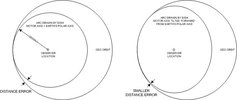dovercat
Member
- Joined
- Nov 24, 2007
- Messages
- 28
- Reaction score
- 0
- Points
- 0
- Age
- 53
- My Satellite Setup
-
Televes 1mtr dish (102x113cm, Gain at 11GHz 40.5dB, Beamwidth 1.98degrees)
Televes 0.5dB LNB
(gain 57dB, discrimination 25dB, oscillator stability +/-2MHz, phase noise max-75dBc@10KHz)
Moteck 2100 Diseqc
Comag sl100hd
- My Location
- 51.6 N, 1.2 W Didcot UK
Since everyone else seems to rate the moteck sg2100 highly, I have decided to replace my failing moteck with a new one.
Well to be honest it is because they can be had for so little money in comparison to other diseqc motors, at least if you shop around. Makes them kind of disposable if installation is straight forward, not up a ladder or paying someone else.
Reading the manual again I have a question.
Why does the Moteck sg2100 instruction manual use the traditional polar mount setup angles, latitude = eleveation?
Do all diseqc H-H mororised mounts do this?
Are they different from traditional polar-mounts that can use the modified elevation/declination angles instead for improved tracking of satellites low in the arc - close to the horizon, while not effecting the tracking of satellites high in the arc?
I assume the moteck uses the traditional angles as the declination angles it instructs you to use also match the traditional system rather than the modified one.
For example
Traditional polar-mount angles are what the moteck manual uses.
Latitude 51. 90-51 = 39 elevation on the motor
Latitude 52. 90-52 = 38 elevation on the motor
For my location 51.6 North this would mean using 38.4 elevation on the motor.
The modified elevation angles you would use on a polar-mount for improved tracking of satellites low in the arc are.
Latitude 51 > 51.67, 90-51.67 = 38.33 elevation on the motor
Latitude 52 > 52.66, 90-52.66 = 37.34 elevation on the motor
For my location 51.6 North this would give
51.6 > 52.27, 90-52.27 = 37.73 elevation on the motor
Can I use this angle like I would for a polar mount, instead of the one in the moteck manual or will it not work?
Well to be honest it is because they can be had for so little money in comparison to other diseqc motors, at least if you shop around. Makes them kind of disposable if installation is straight forward, not up a ladder or paying someone else.
Reading the manual again I have a question.
Why does the Moteck sg2100 instruction manual use the traditional polar mount setup angles, latitude = eleveation?
Do all diseqc H-H mororised mounts do this?
Are they different from traditional polar-mounts that can use the modified elevation/declination angles instead for improved tracking of satellites low in the arc - close to the horizon, while not effecting the tracking of satellites high in the arc?
I assume the moteck uses the traditional angles as the declination angles it instructs you to use also match the traditional system rather than the modified one.
For example
Traditional polar-mount angles are what the moteck manual uses.
Latitude 51. 90-51 = 39 elevation on the motor
Latitude 52. 90-52 = 38 elevation on the motor
For my location 51.6 North this would mean using 38.4 elevation on the motor.
The modified elevation angles you would use on a polar-mount for improved tracking of satellites low in the arc are.
Latitude 51 > 51.67, 90-51.67 = 38.33 elevation on the motor
Latitude 52 > 52.66, 90-52.66 = 37.34 elevation on the motor
For my location 51.6 North this would give
51.6 > 52.27, 90-52.27 = 37.73 elevation on the motor
Can I use this angle like I would for a polar mount, instead of the one in the moteck manual or will it not work?





